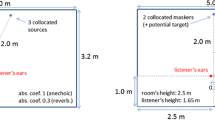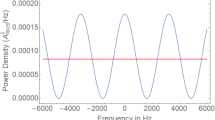ABSTRACT
Humans often have to focus on a single target sound while ignoring competing maskers in everyday situations. In such conditions, speech intelligibility (SI) is improved when a target speaker is spatially separated from a masker (spatial release from making, SRM) compared to situations where both are co-located. Such asymmetric spatial configurations lead to a ‘better-ear effect’ with improved signal-to-noise ratio (SNR) at one ear. However, maskers often surround the listener leading to more symmetric configurations where better-ear effects are absent in a long-term, wideband sense. Nevertheless, better-ear glimpses distributed across time and frequency persist and were suggested to account for SRM (Brungart and Iyer 2012). Here, speech reception was assessed using symmetric masker configurations while varying the spatio-temporal distribution of potential better-ear glimpses. Listeners were presented with a frontal target and eight single-talker maskers in four different symmetrical spatial configurations. Compared to the reference condition with co-located target and maskers, an SRM of up to 6 dB was observed. The SRM persisted when the frequency range of the maskers above or below 1500 Hz was replaced with stationary speech-shaped noise. Comparison to a recent short-time binaural SI model showed that better-ear glimpses can account for half the observed SRM, while binaural interaction utilizing phase differences is required to explain the other half.






Similar content being viewed by others
REFERENCES
Best V, Mason CR, Kidd G Jr, Iyer N, Brungart DS (2015) Better-ear glimpsing in hearing-impaired listeners. J Acoust Soc Am 137:EL213–219. doi:10.1121/1.4907737
Beutelmann R, Brand T (2006) Prediction of speech intelligibility in spatial noise and reverberation for normal-hearing and hearing-impaired listeners. J Acoust Soc Am 120:331–342
Beutelmann R, Brand T, Kollmeier B (2010) Revision, extension, and evaluation of a binaural speech intelligibility model. J Acoust Soc Am 127:2479–2497. doi:10.1121/1.3295575
Bronkhorst AW (2000) The cocktail party phenomenon: a review of research on speech intelligibility in multiple-talker conditions. Acustica 86:117–128
Bronkhorst AW, Plomp R (1988) The effect of head-induced interaural time and level differences on speech intelligibility in noise. J Acoust Soc Am 83:1508–1516
Bronkhorst AW, Plomp R (1992) Effect of multiple speechlike maskers on binaural speech recognition in normal and impaired hearing. J Acoust Soc Am 92:3132–3139
Brown A, Wang AC (2005) Seperation of speech by computational auditory scene analysis. In: Benesty J, Makino S, Chen J (eds) Speech enhancement. Springer, New York, pp 371–402
Brungart DS (2001) Informational and energetic masking effects in the perception of two simultaneous talkers. J Acoust Soc Am 109:1101–1109
Brungart DS, Iyer N (2012) Better-ear glimpsing efficiency with symmetrically-placed interfering talkers. J Acoust Soc Am 132:2545–2556. doi:10.1121/1.4747005
Cherry EC (1953) Some experiments on the recognition of speech, with one and with two ears. J Acoust Soc Am 25:975–979. doi:10.1121/1.1907229
Culling JF, Hawley ML, Litovsky RY (2004) The role of head-induced interaural time and level differences in the speech reception threshold for multiple interfering sound sources. J Acoust Soc Am 116:1057–1065
Cullington HE, Zeng FG (2008) Speech recognition with varying numbers and types of competing talkers by normal-hearing, cochlear-implant, and implant simulation subjects. J Acoust Soc Am 123:450–461. doi:10.1121/1.2805617
Durlach NI (1963) Equalization and cancellation theory of binaural masking-level differences. J Acoust Soc Am 35:1206–1218
Ewert SD (2013) AFC—a modular framework for running psychoacoustic experiments and computational perception models. Proceedings of the International Conference on Acoustics AIA-DAGA 2013 in Merano, Italy: 1326–1329
Freyman RL, Helfer KS, Balakrishnan, U (2005) Spatial and spectral factors in release from informational masking in speech recognition. Acta Acustica united with Acustica 91:537–545
Freyman RL, Helfer KS, McCall DD, Clifton RK (1999) The role of perceived spatial separation in the unmasking of speech. J Acoust Soc Am 106:3578–3588
Glasberg BR, Moore BC (1990) Derivation of auditory filter shapes from notched-noise data. Hear Res 47:103–138
Glyde H, Buchholz J, Dillon H, Best V, Hickson L, Cameron S (2013) The effect of better-ear glimpsing on spatial release from masking. J Acoust Soc Am 134:2937–2945. doi:10.1121/1.4817930
Hawley ML, Litovsky RY, Culling JF (2004) The benefit of binaural hearing in a cocktail party: effect of location and type of interferer. J Acoust Soc Am 115:833–843
Jones GL, Litovsky RY (2011) A cocktail party model of spatial release from masking by both noise and speech interferers. J Acoust Soc Am 130:1463–1474. doi:10.1121/1.3613928
Kidd GJ, Mason CR, Richards VM, Gallun FJ, Durlach NI (2008) Informational masking. In: Yost William A., Popper Arthur N., R. FR (eds) Auditory perception of sound sources, vol 29. Springer US, pp 143–189. doi:10.1007/978-0-387-71305-2_6
Kidd G Jr, Mason CR, Best V, Marrone N (2010) Stimulus factors influencing spatial release from speech-on-speech masking. J Acoust Soc Am 128:1965–1978. doi:10.1121/1.3478781
Lavandier M, Culling JF (2010) Prediction of binaural speech intelligibility against noise in rooms. J Acoust Soc Am 127:387–399. doi:10.1121/1.3268612
Marrone N, Mason CR, Kidd G (2008) Tuning in the spatial dimension: evidence from a masked speech identification task. J Acoust Soc Am 124:1146–1158. doi:10.1121/1.2945710
Martin RL, McAnally KI, Bolia RS, Eberle G, Brungart DS (2012) Spatial release from speech-on-speech masking in the median sagittal plane. J Acoust Soc Am 131:378–385. doi:10.1121/1.3669994
Noble W, Perrett S (2002) Hearing speech against spatially separate competing speech versus competing noise. Percept Psychophys 64:1325–1336
Peissig J, Kollmeier B (1997) Directivity of binaural noise reduction in spatial multiple noise-source arrangements for normal and impaired listeners. J Acoust Soc Am 101:1660–1670
Platte H-J, vom Hövel H (1980) Zur Deutung der Ergebnisse von Sprachverständlichkeitsmessungen mit Störschall im Freifeld. Acta Acustica United with Acustica 45:139–151
Plomp R (1967) Pitch of complex tones. J Acoust Soc Am 41:1526–1533
Plomp R, Mimpen AM (1981) Effect of the orientation of the speaker’s head and the azimuth of a noise source on the speech-reception threshold for sentences. Acustica 48:325–329
Rhebergen KS, Versfeld NJ, Dreschler WA (2006) Extended speech intelligibility index for the prediction of the speech reception threshold in fluctuating noise. J Acoust Soc Am 120:3988–3997
Wagener KC, Brand T, Kollmeier B (1999) Entwicklung und Evaluation eines Satztests für die Deutsche Sprache III: Evaluation des Oldenburger Satztests. Zeitschrift für Audiologie 28:86–95
Wan R, Durlach NI, Colburn HS (2014) Application of a short-time version of the equalization-cancellation model to speech intelligibility experiments with speech maskers. J Acoust Soc Am 136:768–776. doi:10.1121/1.4884767
ACKNOWLEDGMENTS
This work was supported by the Bernstein Center for Computational Neuroscience, the German Center for Vertigo and Balance Disorders (IFB) and the DFG SFB TRR 31. We thank Lisa Benda and Annika Sander for their support during data acquisition.
Author information
Authors and Affiliations
Corresponding author
Rights and permissions
About this article
Cite this article
Lingner, A., Grothe, B., Wiegrebe, L. et al. Binaural Glimpses at the Cocktail Party?. JARO 17, 461–473 (2016). https://doi.org/10.1007/s10162-016-0575-7
Received:
Accepted:
Published:
Issue Date:
DOI: https://doi.org/10.1007/s10162-016-0575-7




